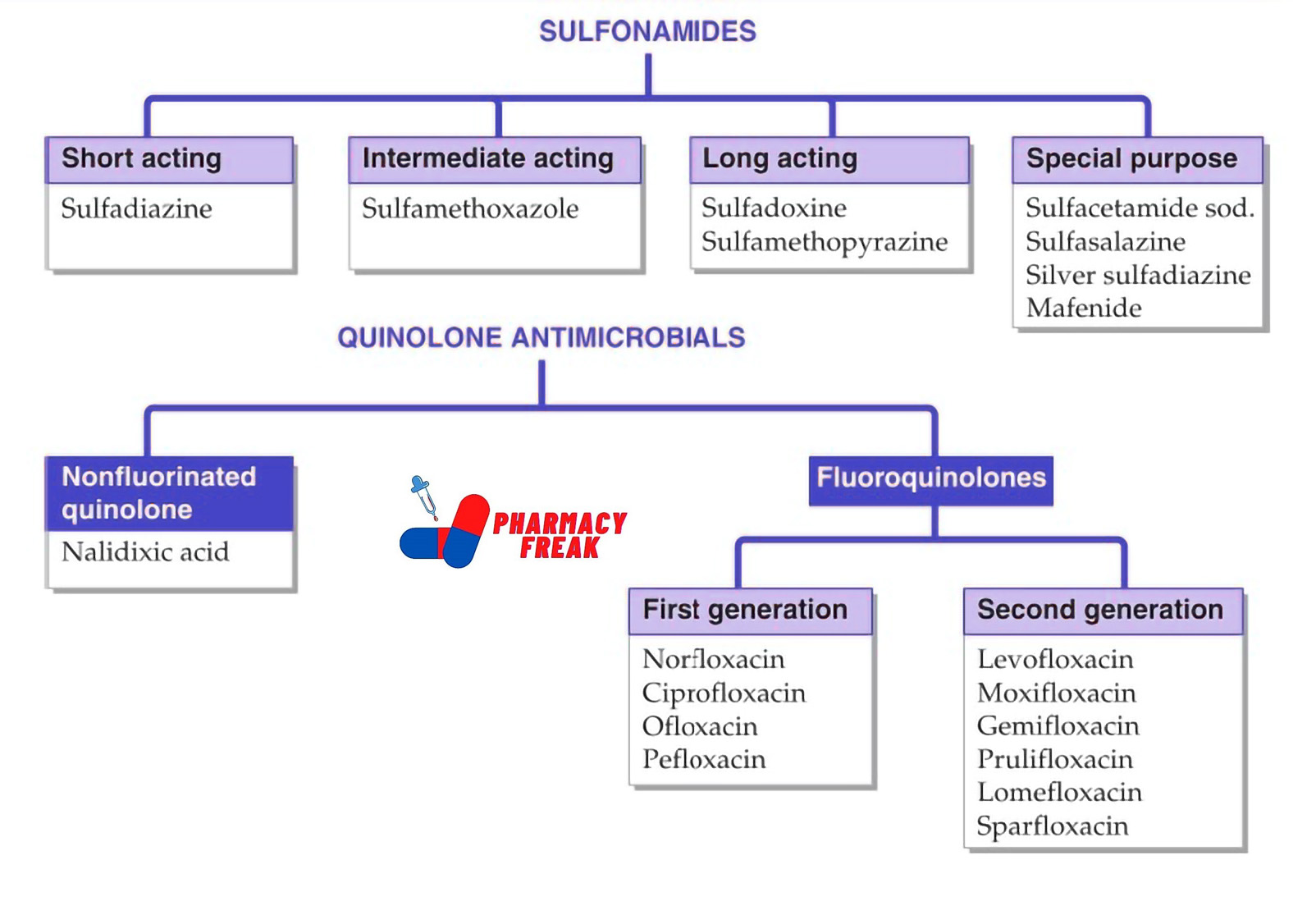- Antibacterial drugs are essential tools in treating infections caused by bacteria. Among them, sulfonamides and quinolones hold a significant place due to their broad-spectrum activity and clinical applications.
- In this blog, we will explore the Classification of sulfonamide and quinolones antimicrobials, their types, mechanisms of action, and clinical uses. This guide is ideal for pharmacy students, healthcare professionals, and anyone interested in understanding the basics of these two important antibiotic classes.
Table of Contents
What Are Sulfonamides?
Sulfonamides, also known as sulfa drugs, are among the oldest classes of synthetic antimicrobial agents. They work by inhibiting folic acid synthesis in bacteria, which is essential for DNA replication and cell survival.
They are bacteriostatic, meaning they stop bacteria from growing rather than killing them directly.
Classification of Sulfonamides
Sulfonamides are classified based on duration of action and special uses:
Short-Acting Sulfonamides
These are rapidly absorbed and excreted.
- Example: Sulfadiazine
- Uses: Urinary tract infections (UTIs), toxoplasmosis (when combined with pyrimethamine)
Intermediate-Acting Sulfonamides
They have a moderate duration and are commonly used in combination therapies.
- Example: Sulfamethoxazole
- Uses: Often combined with trimethoprim as Co-trimoxazole, effective against UTIs, bronchitis, and traveler’s diarrhea
Long-Acting Sulfonamides
These have extended half-lives and are suitable for malaria treatment.
- Examples: Sulfadoxine, Sulfamethopyrazine
- Uses: Malaria, often used with pyrimethamine (as Fansidar)
Special-Purpose Sulfonamides
These are used topically or for specific organ-based infections.
- Examples:
- Sulfacetamide sodium – Used in eye drops for conjunctivitis
- Sulfasalazine – Used in ulcerative colitis and inflammatory bowel diseases
- Silver sulfadiazine – Applied on burns for infection prevention
- Mafenide – Also used for burn wounds
What Are Quinolone Antimicrobials?
Quinolones are synthetic antibacterial agents that target bacterial DNA gyrase and topoisomerase IV, enzymes crucial for DNA replication. They are bactericidal, meaning they directly kill bacteria.
Modern quinolones include fluorine atoms, which enhance their potency and tissue penetration. These are known as fluoroquinolones.
Classification of Quinolone Antimicrobials
Quinolones are classified into:
Non-Fluorinated Quinolones
- Example: Nalidixic acid
- Use: Primarily used for uncomplicated UTIs; rarely used now due to resistance
Fluoroquinolones
These are further classified by generation:
First Generation Fluoroquinolones
Effective mainly against gram-negative organisms.
- Examples: Norfloxacin, Ciprofloxacin, Ofloxacin, Pefloxacin
- Uses:
- UTIs
- Gastrointestinal infections
- Typhoid fever
Second Generation Fluoroquinolones
Have broader coverage, including some gram-positive and atypical pathogens.
- Examples: Levofloxacin, Moxifloxacin, Gemifloxacin, Prulifloxacin, Lomefloxacin, Sparfloxacin
- Uses:
- Respiratory tract infections (e.g., pneumonia, bronchitis)
- Skin infections
- Sinusitis
- Certain STDs
Clinical Uses of Sulfonamides and Quinolones
Here’s how these two drug classes are applied in clinical settings:
| Drug Class | Drug Examples | Common Clinical Uses |
|---|---|---|
| Sulfonamides | Sulfamethoxazole, Sulfadiazine | UTIs, Pneumocystis pneumonia, burns, eye infections |
| Fluoroquinolones | Ciprofloxacin, Levofloxacin | UTIs, typhoid, pneumonia, skin infections, STIs |
Precautions and Side Effects
Both sulfonamides and quinolones can cause side effects:
- Sulfonamides:
- Allergic reactions (rash, fever)
- Stevens-Johnson syndrome (rare but severe)
- Hemolytic anemia (in G6PD-deficient patients)
- Fluoroquinolones:
- Tendon rupture (especially in elderly)
- QT interval prolongation
- CNS effects (dizziness, seizures in rare cases)
They should be used with caution and only under medical supervision.
Antibiotic Resistance and Rational Use
Due to the rise in antimicrobial resistance, sulfonamides and quinolones are used more selectively today. Overuse or misuse leads to bacteria developing resistance, reducing the effectiveness of these important drugs.
To prevent resistance:
- Avoid unnecessary antibiotic use
- Complete the full course of therapy
- Follow the dosage exactly as prescribed
Trivia
- First synthetic antibiotic: Sulfonamides were the first class of synthetic antibiotics, discovered before penicillin became widely used.
- Used in World War II: Sulfa drugs were standard in soldiers’ kits during World War II to treat wound infections on the battlefield.
- Nalidixic acid was an accident: It was discovered as a byproduct during chloroquine synthesis, a drug used for malaria.
- Ciprofloxacin gained global fame: It was one of the first drugs used during the 2001 anthrax bioterrorism scare in the United States.
Reference
- Tripathi, K.D. Essentials of Medical Pharmacology, 9th Edition. Jaypee Brothers Medical Publishers, 2023.Chapter 51 – Sulfonamides, Cotrimoxazole & Quinolones
- Beauduy, C.E., & Winston, L.G. (2017). Sulfonamides, Trimethoprim, & Quinolones. In B.G. Katzung (Ed.), Basic & Clinical Pharmacology (14th ed.). McGraw-Hill Education
Related Topics

I am pursuing MBA in pharmaceutical management from NIPER Hyderabad with a strong academic record and proven success in national-level pharmacy entrance exams. I secured AIR 61 in NIPER 2024 (MS/M.Pharm) and AIR 27 in NIPER MBA, along with AIR 147 in GPAT 2024 and AIR 907 in GPAT 2023. I also achieved AIR 6 in AIIMS CRE-2025 for Drug Store Keeper and was selected as a Pharmacist (AIR 61) for ESIC. Additionally, I was the Runner-Up in Round 2 of the EY Case Study Competition.
At PharmacyFreak.com, I aim to guide future pharmacists through expert content, exam strategies, and insightful resources based on real experience and academic excellence.
Mail- harsh@pharmacyfreak.com
